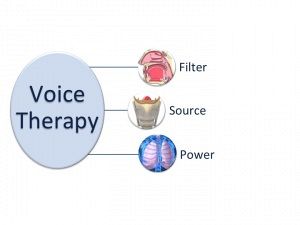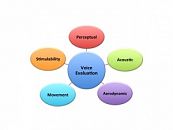Treatment Of Voice Disorders: The Global Voice Therapy Model (GVTM) For Children And Adults #e122
Presenter: Elizabeth U. Grillo, PhD, CCC-SLP
This course explores the components of the Global Voice Therapy Model and application of the GVTM to clinical practice.
– B.R., prior course participant
Read more comments about this course!
The main goal of voice therapy is to optimize the dynamic interactions between the respiratory, laryngeal, and resonating sub-systems for an improved vocal output across all communication tasks. Considering that each client presents with unique anatomy and physiology of phonation, we need the flexibility to determine the most effective voice production technique that will be used in therapy. We also need a voice therapy model that will facilitate generalization and maintenance of the "new" voice.
The Global Voice Therapy Model (GVTM), grounded in motor learning principles, is dedicated to achieving and maintaining the "new" voice in all communication tasks independent of a specific voice production technique. This course will explore the components of the GVTM, motor learning principles applied to the GVTM, research related to the GVTM, and application of the GVTM to clinical practice. The content of the course is for all SLPs in private practice, schools, and medical settings servicing children and adult clients.
Course is offered for 0.2 ASHA CEUs – 2 Contact Hours.
Course Overview – Run Time: 2:00:03
1. Introduction
2. Components of the GVTM
- Methods that augment and support the “new” voice
- Stimulability testing
- Treatment hierarchy
- “New” vs “Old” voice
3. Motor learning principles in the GVTM
4. Research related to the GVTM
5. Application of the GVTM
– J.M., prior course participant
Read more comments about this course!
The content of this online CE course does not focus exclusively on any specific proprietary product or service, however, it does present information on the GVTM which was created by the presenter using funds from a faculty professional development grant. Presenter financial and non-financial disclosures may be found in the Presenter & Disclosures area.
Video PowerPoint presentation with author narration & downloadable handout. Stop and re-start the course at any point. Learners retain access to course content after completion for ongoing reference and review.
Reviews
"I enjoyed the therapy techniques." P.T. (Apr. 2024)
"The concept of negative practice is something I've been missing in my practice that should be helpful. The instructor was very clear and concise." T.W. (Mar. 2024)
"Treatment-specific recommendations were beneficial. I liked the accessibility, treatment methods, and presenter knowledge." K.P. (Jan. 2024)
"I found this method very functional and easy to use. I will be able to use this in my daily practice since I have been receiving more OP voice referrals." S.B. (Dec. 2023)
"Old vs. new voice was a beneficial topic. I liked the therapy treatment videos." B.O. (Nov. 2023)
"I liked the hierarchy of voice treatment and goals." T.W. (Sep. 2023)
"Learning about blocked and random, twang, and new & old voice were helpful. I liked the clinical examples and experiences." A.T. (Sep. 2023)
"I liked having the patient demonstrate "old" vs "new" voice for training purposes. Confirmation of my treatment methods being effective and up to date." J.T. (Jun. 2023)
"The new/old voice contrast was beneficial. I liked the example clips." A.M. (May 2023)
"I liked the actual case scenarios and examples provided in this course." J.M. (Apr. 2023)
"Very applicable to my practice, and right away. Learning random practices with new and old voices were beneficial." E.T. (Mar. 2023)
"Provided treatment techniques associated with various disorders of voice." A.J. (Feb. 2023)
"I liked the stimulability testing and the video/audio examples." A.J. (Feb. 2023)
"Great approach to therapy with a complete toolbox. I liked the therapy techniques, client education, treatment hierarchy, and stabilizing the "new" voice through random practice. All content was very informative." L.H. (Dec. 2022)
"I liked the video samples. This course was well structured and clear. Learning the importance of planned contrast between old and new voice at all levels of the hierarchy." K.D. (Dec. 2022)
"Valuable information. Testing for stimulability was beneficial." S.G. (Dec. 2022)
"Learning voice techniques and how they are applied to improve specific voice impairments. I liked the course format with practice and breaks." T.H. (Nov. 2022)
"Practical and patient-centered approach. I liked the blend of models, the treatment hierarchy with blocked vs random, etc. This is great for carryover." C.H. (Oct. 2022)
"I loved the videos and all of the tips and techniques reviewed. I liked the structure and how all areas of the model were introduced and everything was explained clearly." B.R. (Oct. 2022)
"Clear objectives and targeted instructions. I liked the treatment hierarchy." J.S. (Oct. 2022)
"I liked the examples used by the clinician to demonstrate the particular voice disorder discussed. She did this by her own imitation and by videos of clients." E.B. (Sept. 2022)
"Learning the importance of educating the client each step of the way." E.B. (Sept. 2022)
"The video recordings/examples of each scenario were good. Liked application and demonstration of each technique and component of the GVTM." M.M. (Aug. 2022)
"I liked the video examples." M.B. (Aug. 2022)
"Very specific and detailed description with good examples." J.M. (Jul. 2022)
"The course is very practical. Liked the stimulability, various techniques to try." D.F. (Jul. 2022)
"Very clear presentation with great demonstrations - comparing techniques for voice work for specific voice problems." S.A. (Jul. 2022)
"I will utilize this info in my new job in outpatient with voice patients. I liked the case studies and examples of treatment sessions." I.S. (Jul. 2022)
"I liked the discussion of how to systematically incorporate elements of motor learning while also remaining gestalt or holistic in voice therapy to get quicker patient-centered outcomes and generalization." Z.C. (Jun. 2022)
"I liked the concept of random practice, analogous to stuttering therapy. Also the presenter demos, plus the video and audio samples of her work with actual patients." A.C. (May 2022)
"Some great take-a-ways to use with my adult clients. I liked the use of multiple strategies." L.N. (Feb. 2022)
"Loved the clips of actual sessions." S.H. (Feb. 2022)
"I liked the application of the GVTM model – utilization of the various stimulability and therapy approaches – demonstration of the different stimulability techniques and approaches along with the descriptions of when they are often used and helpful." S.S. (Jan. 2022)
"I liked the specific treatment program, and the ease of course access." S.F. (Jan. 2022)
"The course was structured to be practical and make sense. I liked the blocked and random practice and hierarchy." J.D. (Dec. 2021)
"I liked the examples of voice techniques and hierarchy to help promote learning and self-awareness." L.R. (Dec. 2021)
"I enjoyed the actual focus on real life application of the GVTM to assessment and treatment of patients. The concept of old vs new voice and how to get the client to achieve generalization of new voice in a short period of time for improved quality of life." T.G. (Dec. 2021)
"I liked the client videos and the discussion on not focusing on the articulatory specifics (just the sound)." S.R. (Dec. 2021)
"I appreciated the flash case descriptions at the end, since this allowed us to reflect quickly, as in a therapy situation, on how to proceed following all the components and strategies learned in the rest of the training." J.M. (Dec. 2021)
"How to achieve generalization of new voice by practicing "new" vs. "old" voice in each step of the treatment hierarchy was the topic most beneficial for me." A.C. (Nov. 2021)
"I liked everything! Great ideas! And I liked the case scenarios." C.O. (Nov. 2021)
"I really liked the variety of voice therapy techniques...excellent work at combining various techniques depending on each client's needs. I appreciated the global approach of the voice therapy procedure." I.K. (Nov. 2021)
"Liked that she broke down the different methods that could be used to treat voice disorders and how to implement them with clients." C.M. (Oct. 2021)
"Gave me new approaches for structuring sessions and home practice with my clients. The examples of the voice techniques were good." S.S. (Sept. 2021)
"Superb video and audio examples - all were of sufficient length to give listeners a good sense of the procedure as well as ample time to see an expert applying them with real people. Also very much appreciated the detailed listings of elements of respective pieces of service delivery (ex: vocal hygiene examples)." D.D. (Sept. 2021)
"I liked everything about the random practice to produce the new and the old voice. It will change the way I will bring consciousness of the old vs the new voice of the patient. I really like all the examples (video and audio). It was really helpful." S.C. (Aug. 2021)
“I enjoyed learning about voice techniques that I had minimal experience incorporating into daily practice. And it was helpful for my setting.” E.B. (Aug. 2021)
“I found talking about the treatment portion the most beneficial because all the steps were explained, and examples were given of what it might look like in the clinical setting.” L.U. (Jun. 2021)
“The course was excellent both from the research to the outlined treatment program. The video and audio presentations were also most helpful as examples of the outlined hierarchy of the GVTM voice therapy model.” A.B. (May 2021)
“I liked the video clips, it really helps to see it in action.” D.E. (Feb. 2021)
"I appreciated the discussion on treatment hierarchy. Her examples of treatment will help me with my patients. I really like her system. Presenter was thorough with defining and explaining treatment strategies." C.R. (Feb. 2021)
"I really enjoyed seeing the presenter and her examples as well as the case study videos...they were excellent! I am a very visual learner so this helped with my understanding on how to implement and think about therapy." R.R. (Jan. 2021)
Course Objectives
- Describe the components of the GVTM.
- Explain the motor learning principles applied to the GVTM.
- Summarize the research supporting the GVTM.
- Apply the GVTM to clinical practice.
- Identify appropriate use of the GVTM in client examples and self-practice.
Presenter & Disclosures

Elizabeth U. Grillo, PhD, CCC-SLP, is an associate professor in the Department of Communication Sciences and Disorders at West Chester University of Pennsylvania (WCU). After earning a bachelor's of music in voice performance from Indiana University, she pursued a career change to speech-language pathology by earning an M.S. at Teachers College Columbia University and a Ph.D. at the University of Pittsburgh. Her clinical expertise is in voice disorders and in medical speech-language pathology. Currently, her research related to voice is addressing aerodynamic measures, the Global Voice Prevention and Therapy Model, apps, and telepractice. Her research has been supported by grants at WCU and an R15 from the National Institute on Deafness and Other Communication Disorders (NIDCD) of the National Institutes of Health. Her work has been disseminated through peer-reviewed publications and presentations at local, state, and national conferences.
Speaker Disclosures:
Financial — Elizabeth Grillo is an employee of West Chester University (WCU); receives a salary. Pilot work of the Global Voice Prevention and Therapy Model (GVTM) was funded by a WCU Faculty Professional Development Grant. Dr. Grillo’s work related to telepractice is funded through the NIDCD, grant number R15DC014566.
Financial — Elizabeth Grillo is a presenter of online CE courses sponsored by Northern Speech Services; receives royalties.
Nonfinancial — Elizabeth Grillo is the developer of the Global Voice Prevention and Therapy Model (GVPTM).
Intended Audience / Accreditation

This program is offered for 0.2 ASHA CEUs (Intermediate Level; Professional Area).

Intended Audience
- Speech-Language Pathologists
ASHA CEUs: NSS online courses are registered with ASHA and are offered for ASHA CEUs. The number of ASHA CEUs is noted above. Note that 0.1 ASHA CEU = 1 contact hour = equals 1 CEE.
ASHA CE Registry: During the enrollment process, if you select to receive ASHA credit for this course and if you provide your ASHA number, NSS will automatically submit your CEU information to the ASHA CE Registry after successful course completion (80% on post test). This submission happens once per month, during the first week of the month. For example, if you complete your course on November 7th, NSS will submit all November online course CEUs to ASHA during the first week of December. When ASHA inputs the information into their database, they will mark the course as completed on the last day of the month in which it was completed, so November 30th using this example. The certificate of completion available for you to print immediately, however, will reflect the actual completion date, November 7th in this example. Due to ASHA processing procedures please allow 2-3 weeks, from the submission date, for the course to appear on your ASHA transcript.
ASHA CEUs: Attendees must meet at least one of the following conditions in order to be eligible to earn ASHA CEUs:
- Current ASHA Member
- ASHA Certificate of Clinical Competence (CCC) Holder
- Licensed by a state or provincial regulatory agency to practice speech-language pathology (SLP) or audiology
- Credentialed by a state regulatory agency to practice SLP or audiology
- Credentialed by a national regulatory agency to practice SLP or audiology
- Engaged in a Clinical Fellowship under the supervision of an individual with their ASHA CCC
- Currently enrolled in a master's or doctoral program in SLP or audiology
If an attendee is not an ASHA member or CCC holder but meets any of the above criteria, they may inform the ASHA CE Registry of their eligibility by visiting this site.
Licensing Boards: Most state licensing boards DO accept CEUs earned online (usually classified as home-study credits). Some state boards do, however, place a limit to the number of credits that can be earned via home study/online courses. For the most current information, we suggest that you contact your licensing board or agency to verify acceptance policies and/or any credit limits related to home-study courses prior to registering for this course.
Additional accrediting agencies by which Northern Speech is an approved CE provider:
- California: NSS is approved as a provider of continuing education by the California Speech-Language Pathology & Audiology Board. Provider #PDP4. Online CEU limits may apply; please contact SLPAHADB for current online CEU acceptance policies.
- Iowa: NSS is approved as a provider of continuing education by the Iowa Board of Speech Pathology and Audiology Examiners. Provider #169.
- Kansas: NSS is approved as a provider of continuing education by the Kansas Department of Health and Environment. Provider #LTS-S0005.
Frequently Asked Questions
Customer Support: Please phone 888.337.3866 or email info@northernspeech.com.
Course Completion Timeframe:
You have unlimited time to complete our online courses. You may log off and log on as often as you’d like to in order to complete all sections of a course.
However, completion dates are based on Eastern Standard Time. Therefore, if you need your CEUs by a certain date, be sure to complete the course test before 11:59pm EST on that date. For example, if you need CEUs before January 1st, you will need to complete the course test before 11:59pm EST on December 31st.
Content Access:
Access to course materials and content does not expire, even after completing the post test. You may continue to review course material by logging into your NSS account, clicking the My Online Courses tab, and then viewing your desired course.
Certificate of Completion:
On successful completion of the post test (80%), a certificate will be immediately available for download and/or printing. This certificate will include your name, date of completion (based on Eastern Time Zone, USA/Canada), and number of contact hours (CEUs / CEEs). Please note that CEUs are awarded on the date of successful test completion, not the date of course enrollment. Please ensure that you successfully complete the post test prior to any licensure renewal dates.
ASHA CE Registry Submission:
During the enrollment process, if you select to receive ASHA credit for this course and if you provide your ASHA number, NSS will automatically submit your CEU information to the ASHA CE Registry after successful course completion (80% on post test). This submission happens once per month, during the first week of the month. For example, if you complete your course on November 7th, NSS will submit all November online course CEUs to ASHA during the first week of December. When ASHA inputs the information into their database, they will mark the course as completed on the last day of the month in which it was completed, so November 30th using this example. The certificate of completion available for you to print immediately, however, will reflect the actual completion date, November 7th in this example. Due to ASHA processing procedures please allow 2-3 weeks, from the submission date, for the course to appear on your ASHA transcript.
Purchase Orders:
Purchase orders are currently not accepted for online orders, if you wish to submit a purchase order please do so at info@northernspeech.com or fax to 888-696-9655.
What is an Online Course?
Our Online Courses consist of video, audio, and/or text content and are offered for ASHA CEUs. Unlike a webinar, which requires participants to be logged on and at a computer at specific times, our Online Courses are available to you at any time, from any device, via your NorthernSpeech.com online account. You may work at your own pace and start and stop your course as you wish. Your course will conclude with a short post test. On successful completion of the post test (>80%), a printable certificate of completion is presented to you.
Receiving CEUs:
Northern Speech is an ASHA CE Provider and our online courses are registered with ASHA and offered for ASHA CEUs. Please note that successful completion of the online post test is required prior to the awarding of CEUs. Please contact your state licensing board for acceptance policies related to CEUs earned online. Please note that courses offered for university students are not applicable for CEUs.
Registering for an online course:
You may browse all online courses by clicking the Continuing Education tab above, then Online Courses. Once you find a course, click Enroll Now, and you will be asked to either log into your existing Northern Speech account or create a new online account. Once you’ve entered your account information and provided your credit card payment, your course will be immediately available to you.
Accessing your purchased course or returning to a purchased course:
You will be able to access your online course by logging into your Northern Speech account and then clicking the My Online Courses tab on your profile screen. Click the course you would like to start or to resume. From there, proceed through the course sections until you are ready to complete the post test. You do not have to complete your course all at once. You may log on and off as you wish.
Testing requirements:
Each online course concludes with a post test consisting of multiple choice or true & false questions. Scores of 80% or greater are required for successful course completion and awarding of CEUs. You may revisit course materials and retest as needed to achieve a passing score.
Number of CEUs offered:
We offer courses from 1 to 21 contact hours. Each course will note the number of CEUs offered. Please note that 0.1 CEU = 1 contact hour = 1 CEE.
State licensing boards and online CEUs:
NSS is an ASHA CE Provider and most state licensing boards DO accept ASHA CEUs earned online (usually classified as home-study credits). Some boards do, however, place a limit to the number of CEUs that can be earned via home study/online courses. For the most current information, we suggest that you contact your licensing board or agency to verify acceptance policies and/or any CEU limits related to home-study courses prior to enrolling in an online course.
Course formats:
Our course formats include: text, audio, video, and PowerPoint with author narration. Each course will note the format on the course description page. Most courses include closed captioning.
Course handouts:
Most of our online courses provide a link to download the accompanying handout as a PDF file.
Group discounts:
Groups of 3 or more are eligible for a 20% discount on each registration on most of our online courses. To receive this discount, registrations need to be processed together via the "Group Rates" tab on the Online Course of your choice.
Computer requirements:
For our online courses to function best, we recommend that you update your computer to include the newest version of your Internet browser (Safari, Chrome, Firefox, Edge, Internet Explorer, etc.) and newest version of your computer's operating system. Also a high-speed Internet connection is recommended (cable or DSL). Speakers or headphones will be required for many of our courses as many contain audio components.
Course Cancellation Policy:
A purchased online course can be exchanged, refunded, or transferred to another individual if contact is made with NSS (via phone or email) within 30 days of purchase and the course materials have not been viewed or downloaded.
Special Needs:
Please click here for any special needs requests, and we will do our best to accommodate them.
| Contact Us |


